Plastic characterization and performance of SnAgCuBiNi/Cu lead-free BGA solder joints*
2015-10-31YangMiaosenSunFenglianandKongXiangxia
Yang Miaosen,Sun Fenglian and Kong Xiangxia
杨淼森,孙凤莲,孔祥霞**
Plastic characterization and performance of SnAgCuBiNi/Cu lead-free BGA solder joints*
Yang Miaosen,Sun Fenglian and Kong Xiangxia
杨淼森,孙凤莲,孔祥霞**
Nanoindentation test is performed on study the plastic and creep properties of the Sn-Ag-Cu(SAC)lead-free ball grid array(BGA)solder joints.The dynamic hardness of two kinds of solder joints decreases with indentation depth increase. SAC0705BiNi/Cu exhibits a higher ultimate dynamic hardness and a smaller indentation depth than SAC305/Cu.Then the strain hardening phenomenon of SAC305/Cu is more obvious compared to that of SAC0705BiNi/Cu.The indentation creep of SAC0705BiNi/Cu solder joint is lower than that of SAC305/Cu solder joint before and after thermal shock.The creep rate sensitive index of SACBiNi/Cu solder joint is lower than that of solder joint.SAC0705BiNi/Cu solder joint is superior to SAC305/Cu solder joint in the anti-creep property.The plasticity of SAC0705BiNi/Cu and SAC305/Cu solder joints are similar.Compared with SAC305 solder,the SAC0705BiNi solder performs higher hardness and solder creep resistance and still maintains a good plasticity.
ball grid array solder joint,creep resistance,plasticity,nanoindentation
0 Introduction
With the development of package technology,the size of solder ball becomes smaller and smaller to ball grid array(BGA)packaging products.The diameters of common solder balls are only a few hundred microns even below 50 μm in some application areas.The stress,current,and thermal loading(such as mechanical fatigue,thermal fatigue,impact)of a single solder joint become more and more serious in service.The plasticity greatly affects the reliability of solder joints.Therefore,it is very important to understand the behavior of plastic and creep deformation for both alloys selection and life improvement of solder interconnects.
Nanoindentation method has a lot of particular advantages on study micro-mechanical properties of materials.It can obtain the hardness and elastic modulus of materials. Researchers described the plastic properties by defining a new method,and the results are verified by numerical simulation of nanoindentation experiments of metals and ceramics[1-4].
In the field of micro-electronics packaging,nanoindentation technique is widely used on the study of mechanical properties of micro solder joints.However,more efforts focused on the indentation hardness,mechanical properties such as elastic modulus measurement and comparison aspects.For plastic study,some studies are mainly focused on creep analysis[5-12].
To solve the above issues,nanoindentation method is used to evaluate the dynamic hardness,creep characteristics and the ratio of plastic strain of solder joints.Moreover,different kinds of plastic behaviors of BGA solder joints are also compared.
1 Determination of mechanics parameters
The typical indentation load-depth curve for solder alloy is shown in Fig.1.Pmand hmare the maximum loadand maximum indentation depth,respectively.The hpis the residual indentation depth after unloading and S represents the stiffness of elastic contact corresponding with the top slope of unloading curve in the test.The intercept of tangent line and axis is defined as hc.
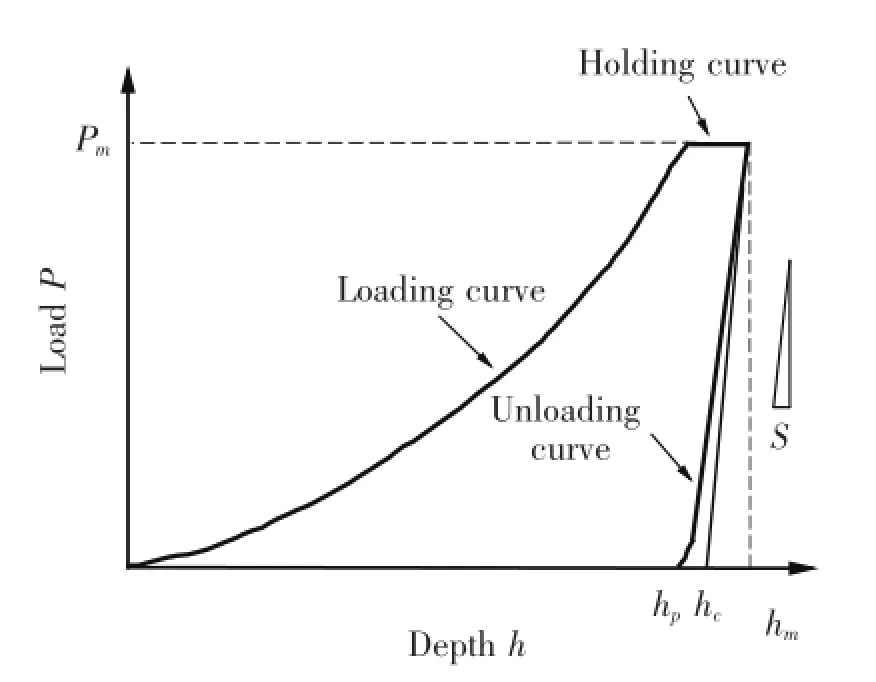
Fig.1 Typical indentation load-depth curve for solder alloy
The hardness and elastic modulus obtained from indentation test can be depicted as follows:

where P is the load,A is the projected contact area under the load.For Berkovich indenter,A can be delivered as

and h can be delivered as

where h is the ruled contact depth between the indenter and test section,ε is the correction factor of indenter shape depending on the indenter geometry.ε is equal to 0.75 for the triangular pyramid indenter.
Eris obtained by indentation test and can be defined as

where β is the correction coefficient of asymmetric pressure head(for Berkovich indenter,β is equal to 1.034).
Elasticity coefficient E value of indentation can be calculated by Ervalue.

where E and ν represent is the Young modulus and Poisson ratio of tested materials,respectively.For Berkovich indenter,Eiis 1 114 GPa and νiis 0.07.
As shown in Fig.2,the hardness measured from indentation process can be described as
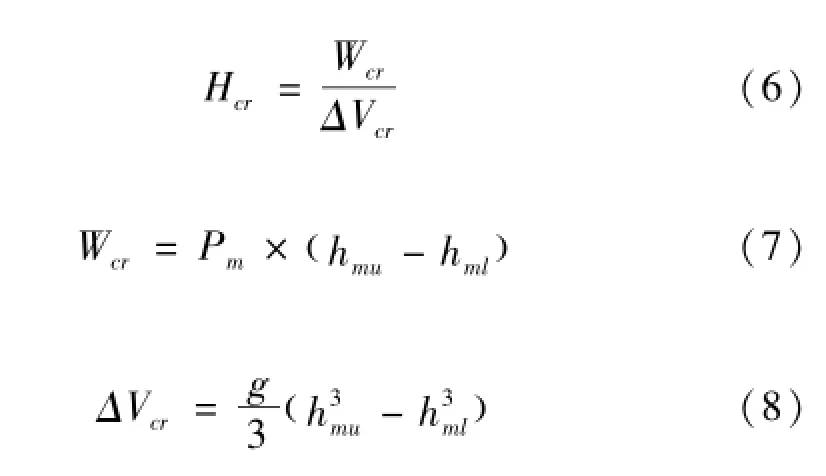
where g is the shape factor of Berkovich pressure and Hcrrepresents creep hardness.Wcris the creep work,ΔVcris the form volume of creep.hmlis the loaded displacement at the maximum load and hmuis the displacement of initial unloaded point.

Fig.2 Schematic of creep deformed volume during hold time in an indentation test[7]
2 Experimental materials and method
Pure elements of Sn,Ag,Cu,Bi and Ni were se-lected as alloy elements of the experiment.Two types of solder alloys Sn0.7Ag0.5Cu3.5Bi0.05Ni(SAC0705BiNi)and Sn3.0Ag0.5Cu(SAC305)were prepared in quartz vessel and heated in high frequency induction melting equipment with the protection of pure argon gas.
BGA balls with the diameter of 760 μm were fabricated and then placed on a coin welding plate.Alcohol-rosin was used as flux to get BGA solder joints in a reflow soldering oven named as T340C.Peak temperature of reflow soldering was 260℃ and insulation time was 60 s.Total welding time was 560 s.Thermal shock test was conducted by a self-designed thermal shock tester from 60℃ to 150℃ (5 min per circle)for 100 h.
Nanoindentation test was performed on a Shimadzu-DUH-211S Nano-hardness tester.A Berkovich indenter was used to fulfill the indentation test for solder joints.
The load-unload test mode was used and the indentation interval was kept beyond 5 times indentation size.Indentation force was set at 200 mN with the load rate of 5 mN/s,10 mN/s,15 mN/s,20 mN/s,and 50 mN/s,respectively.Holding time at maximum load was 5 s.The final result was the average value of 5 experiments.
The creep performance of the solder joints after thermal shock was measured under the maximum load of 50 mN with the rate of 4.44 mN/s,and the holding time of 10 s.
3 Experimental results and analysis
3.1The indentation dynamic hardness of solder joints
Dynamic nanoindentation hardness is obtained from the loads and instantaneous indentation depths in loading process according to the JIS(Japan Industrial Standards). Fig.3 shows the dynamic hardness-depth curves of SAC305/ Cu and SAC0705BiNi/Cu.
The hardness of two kinds of solder joints decreases with the indentation depth increases under the same load. The smaller the indentation depth is,the higher hardness is.This indicates a clear indentation size effect.
The decrease rate of dynamic hardness has significant changes at the vicinity of 1.1 μm depth,because the classical theory does not apply to the microscopic plastic deformation at the microscope[13-15].Whenindentation depth is relatively smaller,deformation resistance of GND(geometrically necessary dislocation)and SSD(statistically stored dislocation)arisen of strain gradient can be improved.Thus,the materials are strengthened and the indentation size effect occurred[16-17].
For the solder joints of SAC0705BiNi/Cu,the resistance of dislocation motion increase and material strength is also improved because of the solid solution strengthening effect of Bi elements and fine-grain strengthening effect of Ni element.
A lot of Ag3Sn phases widely disperse in the matrix which played a very important role on the dispersion strengthening in SAC305/Cu solder joints.
The decrease rate of hardness of SAC305/Cu solder joints reduce with the decrease of the indenter depth.It is illustrated that significant hardening phenomenon happened during the process of initial indentation.
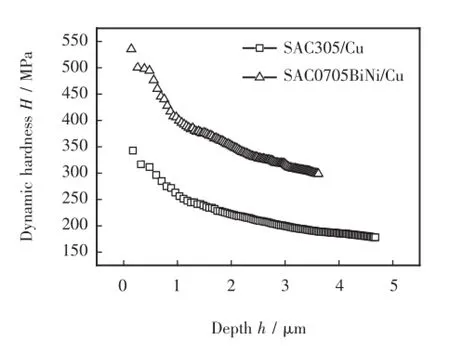
Fig.3 Dynamic hardness-depth curves of SAC305/Cu and SAC0705BiNi/Cu
3.2The creep performance of solder joints
Fig.4 shows the indentation load-depth curves for SAC305/Cu and SAC0705BiNi/Cu at maximum load of 200 mN with loading rate of 5 mN/s.The comparison in creep performance of different lead-free BGA solder joints is illustrated in Table 1.Creep depth refers to the change of indentation depth in the process of load holding.Creep hardness indicates in the resistance of plastic deformation of materials in the creep process.As can be seen from Table 1,under the same conditions,SAC0705BiNi/Cu is lesser in the creep depth and far higher in creep hardnesscompared to SAC305/Cu.These further illustrate that the creep resistance of SAC0705BiNi/Cu is higher than that of SAC305/Cu in the process.

Fig.4 Indentation load-depth curves for SAC305/Cu and SAC0705BiNi/Cu

Table 1 Comparison in creep performance of SAC305/Cu and SAC0705BiNi/Cu
Fig.5 shows the relationship between loading rate with creep depth for SAC305/Cu and SAC0705BiNi/Cu. As can be seen,indentation creep depth has a positive correlation with loading rate.Under the same loading rate,the creep depth of SAC0705BiNi/Cu is smaller than that of SAC305/Cu.When the loading rate is 50 mN/s,the creep depth of SAC0705BiNi/Cu solder does not increase apparently.Itshowsthatthecreepresistanceof SAC0705BiNi solder is stronger.The SAC0705BiNi solder has better creep resistance properties at high loading rate.
In accordance with the ISO14577 standard,indentation creep test can be used to characterize creep resistance performance of solder joint.Fig.6 shows the indentation creep rate(Cit)of SAC0705BiNi/Cu and SAC305/Cu solder joints.Afterthermalshocktest,theCitof SAC0705BiNi/Cu solder joints is 6.78,while that of SAC305/Cu solder joints is 10.53.The creep resistance performance of SAC0705BiNi/Cu is better.

Fig.5 Relationship between loading rate with creep depth for SAC305/Cu and SAC0705BiNi/Cu
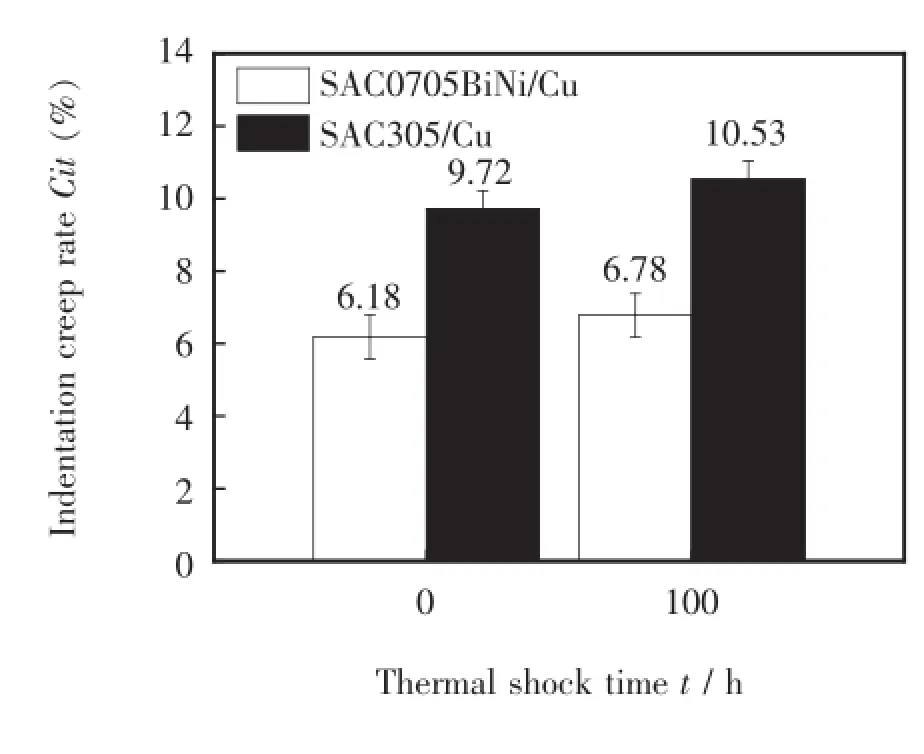
Fig.6 Indentation creep rate(Cit)of SAC0705BiNi/Cu and SAC305/Cu solder joints
ThestrainratesensitivitymofSAC305/Cu,SAC0705BiNi/Cu solder can be obtained by fitting method in Fig.7.The indexes n are 8.772 and 11.274 respectively corresponding to the values of m as 0.114 and 0.088 7.Among them,the creep strain rate sensitivity index of SAC305/Cu solder is close to the value of 0.111 1 reported in Reference[7],which illustrates that SAC305/ Cu,SAC0705BiNi/Cu solder obey the second-phase particle reinforced mechanism and its creep is controlled by the dislocation motion of non-basal plane.The creep properties of lead-free solder are related to the composition of the solder alloy.
Silver element in SAC305 alloy is widely scattered inthe matrix in the form of a large number of intermetallic compounds,which enhances the creep resistance of the substrate.For low-silver alloy SAC0705BiNi,Bi element can improve alloy hardness and creep resistance properties by the solid solution strengthening effect.The interaction of Cu and Ni elements increase the content of intermetallic compounds and improve the solder creep-resistance ability.
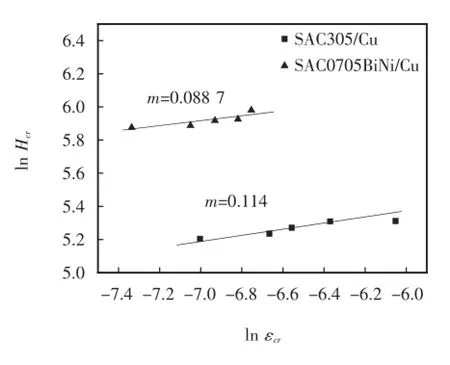
Fig.7 Fitting curve of the creep strain rate sensitivities for SAC305/Cu and SAC0705BiNi/Cu
3.3Comparison of plastic deformation characteristics of two types of BGA solder joint
Table 2 shows the δHvalues of two components of BGA solder joints,calculated by the test results of loading rate of 10 mN/s under the maximum load 200 mN.

Table 2 δHValues of two components of BGA solder joints
The plasticity of SAC305/Cu and SAC0705BiNi/Cu solder joints are equally good,solder joints plasticity is influenced by the content of added alloying elements. SAC0705BiNi performs better comprehensive mechanical properties between the two solders because of the improvement of the hardness and elastic modulus of solders,and maintains a good plastic performance added Bi and Ni elements.
4 Conclusions
(1)The ratio of the plastic strain and the total strain are obtained from indentation tests,and it is used as plasticity index to evaluate the joints plasticity of two kinds of solder alloys.Alloy elements have a great influence on plasticdeformationabilityofsolderjoints.The SAC0705BiNi/Cu solder and SAC305/Cu solder showed equally good plasticity.In the process of initial tip penetration,SAC305/Cu solder joints exhibited strain hardening.
(2)Deduced from the relationship between creep hardness and creep strain rate under different loading rates,strain rate sensitivity indexes m of SAC305/Cu and SAC0705BiNi/Cu solder joints are 0.114 and 0.088 7 respectively.The corresponding creep stress exponents n are 8.772 and 11.274,respectively.
[1] Bellemare S C,Dao M,Suresh S.A new method for evaluating the plastic properties of materials through instrumented frictional sliding tests.Acta Materialia,2010,58(19):6385 -6392.
[2] Huang Y,Liu X,Zhou Y,et al.Mathematical analysis on the uniqueness of reverse algorithm for measuring elastic-plastic properties by sharp indentation.Journal of Materials Science&Technology,2011,27(7):577-584.
[3] Baxevani E A,Giannakopoulos A E.The modified rockwell test:A new probe for mechanical properties of metals.Experimental Mechanics,2009,49(3):371-382.
[4] Millman Y V.Indentation of materials as a new method of micromechanical testing.Powder Metallurgy metal Ceramics,1999,38(7-8):396-402.
[5] Zhang G,Jing H,Lianyong X U,et al.Thermo mechanical characterization of 80Au/20Sn solder using nanoindentation. Transactions of the China Welding Institution,2009,30(9):53-56.(in Chinese)
[6] Chromik R R,Vinci R P,Allen S L,et al.Measuring the mechanical properties of Pb-free solder and Sn-based intermetallics by nanoindentation.JOM,2003,55(6):66-69.
[7] Wang F J,Qian Y Y,Ma X.Measurement of mechanical properties of Sn-Ag-Cu bulk solder BGA solder joint using nanoindentation.Acta Metallrugica Sinica,2005,41(7):775-779.(in Chinese)
[8] Ji F,Xue S B,Liu S,et al.Measurement of creep stress exponent of Zn-Al filler metal at room temperature by using nanoindentation.Transactions of the China Welding Institution,2013(2):75-78.(in Chinese)
[9] Yang M S,Sun F L,Zou P F.Plasticity and creep performance of low-Ag SnAgCuBi-xNi/Cu solder joint.Transactions of the China Welding Institution,2014,35(3):31-34.(in Chinese)
[10] Gao F,Nishikawa H,Takemoto T,et al.Mechanical properties versus temperature relation of individual phases in Sn-3.0Ag-0.5Cu lead-free solder alloy.Microelectronics Reliability,2009,49(3):296-302.
[11] Dudek M A,Chawla N.Nanoindentation of rare earth-Sn intermetallics in Pb-free solders.Intermetallics,2010,18(5):1016-1020.
[12] Chandra Rao B S S,Weng J,Shen L,et al.Morphology and mechanical properties of intermetallic compounds in SnAgCu solder joints.Microelectronic Engineering,2010,87(11):2416-2422.
[13] Nix W D.Mechanical properties of thin films.Metallurgical Transactions A,1989,20(11):2217-2245.
[14] Nix W D.Elastic and plastic properties of thin films on substrates:nanoindentation techniques.Materials Science& Engineering A,1997,234(9):37-44.
[15] Mcelhaney K W,Vlassak J J,Nix W D.Determination of indenter tip geometry and indentation contact area for depthsensing indentation experiments.Journal of Materials Research,1998,13(5):1300-1306.
[16] Fleck N A,Muller G M,Ashby M F,et al.Strain gradient plasticity:Theory and experiment.Acta Metallurgica&Materialia,1994,42(94):475-487.
[17] Ashby M F.The deformation of plastically non-homogeneous materials.Philosophical Magazine,1970,21(170):399-424.
*This work was supported by National Natural Science Foundation of China(Grant No.51174069 and 51075107)and Research Special Funds for Technology Creative Talents of Harbin(Grant No.2013RFQXJ166).
**Yang Miaosen,Sun Fenglian and Kong Xiangxia,School of Material Science and Engineering,Harbin University of Science and Technology,Harbin,150040. Yang Miaosen,Harbin Vocational and Technical College,Harbin,150040.Sun Fenglian,Corresponding author,E-mail:Sunfengl@hrbust.edu.cn
杂志排行
China Welding的其它文章
- New filler metal systems for the brazing of titanium alloys
- Effect of gallium addition on microstructure and properties of Ag-Cu-Zn-Sn alloys*
- Influence of Mn on wettability and microstructure of low-silver lead-free solders*
- Macrostructures and mechanical properties of ultrasonic-assisted friction stir welding joint of 2024-T3 aluminium alloy
- Influences of acoustic field parameters on welding arc behavior in ultrasonic-MIG welding*
- Microstructure evolution in the weld metal region of a Ni-based Inconel 718 superalloy produced by tungsten inert gas welding
